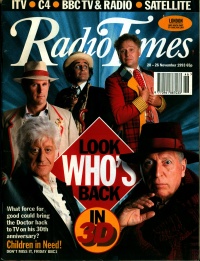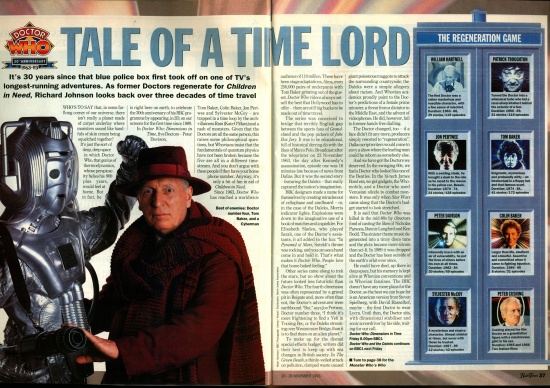Tale of a Time Lord

30th anniversary special
20 November 1993

10th (1973) | 20th (1983) | 30th (1993) | 40th (2003) | 50th (2013)
- Publication: Radio Times
- Date: 1993-11-20
- Author:
- Page: 36
- Language: English
It's 30 years since that blue police box first took off on one of TV's longest-running adventures. As former Doctors regenerate for Children in Need, Richard Johnson looks back over three decades of time travel
WHO'S TO SAY that, in some far-flung corner of our universe, there isn't really a planet made of carpet underlay where monsters sound like handfuls of skin cream being squelched together?
It's just the sort of deep, deep space in which Doctor Who, that genius of thermodynamics, whose perspicacity belies his 900 plus years, would feel at home. But in fact, he is right here on earth, to celebrate the 30th anniversary of his BBC programme by appearing, in 3D, on our screens for the first time since 1989. In Doctor Who: Dimensions in Time, five Doctors — Peter Davison,
Tom Baker, Colin Baker, Jon Pertwee and Sylvester McCoy — are trapped in a time loop by the arch-villainess Rani (Kate O'Mara) and a rash of monsters. Given that the Doctors are all the same person, this raises some philosophical questions, but Whovians insist that the fundamentals of quantum physics have not been broken because the five are all in a different time-stream. And you don't argue with these people if they have your home phone number. Anyway, it's only a bit of fun in aid of Children in Need.
Since 1963, Doctor Who has reached a worldwide audience of 110 million. There have been stage adaptations, films, even 250,000 pairs of underpants with Tom Baker grinning out of the gusset. Doctor Who videos always outsell the best that Hollywood has to offer — there are still big bucks to be made out of time travel.
The series was conceived to bridge that terribly English gap between the sports fans of Grandstand and the pop pickers of Juke Box Jury. It was to be educational, full of historical derring-do with the likes of Marco Polo. Broadcast after the teleprinter on 23 November 1963, the day after Kennedy's assassination, episode one was 16 minutes late because of news from Dallas. But it was the second story featuring the Daleks — that really captured the nation's imagination.
BBC designers made a name for themselves by creating miracles out of cellophane and cardboard — or, in the case of the Daleks, Morris indicator lights. Explosions were down to the imaginative use of a book of matches and a sparkler. For Elisabeth Sladen, who played Sarah, one of the Doctor's assist tants, it all added to the fun: "In Pyramid of Mars, Sutekh's throne was rocking, and you can see a hand come in and hold it. That's what makes it Doctor Who. People love that home-baked feeling."
Other series came along to trek the stars, but no show about the future looked less futuristic than Doctor Who. The fourth dimension was often represented by a gravel pit in Reigate and, more often than not, the Doctor's adventures were earthbound. 'But," says Jon Pertwee, Doctor number three, "I think it's more frightening to find a Yeti in I Tooting Bec, or the Daleks streaming over Westminster Bridge, than it Is to find them on an alien planet." To make up for the dismal special-effects budget, writers did their best to keep up with sea hanges in British society. In The Green Death, a thinly-veiled attack n pollution, dumped waste caused giant poisonous maggots to attack the surrounding countryside; the Daleks were a simple allegory about racism. And Whovian academics proudly point to the Doctor's predictions of a female prime minister, a threat from a dictator in the Middle East, and the advent of videophones. He did, however, fail to foresee hands-free dialling.
The Doctor changed, too — if a face didn't fit any more, producers simply resorted to "regeneration". Dallas scriptwriters would come to envy a show where the leading man could be reborn as somebody else.
And we have got the Doctors we deserved. In the swinging 60s, we had a Doctor who looked like one of the Beatles. In the hi-tech James Bond era, we got gadgets, the Who-mobile, and a Doctor who used Venusian aikido to combat monsters. It was only when Star Wars came along that the Doctor's budget started to look stretched.
It is said that Doctor Who was killed in the mid-80s by directors fond of casting the likes of Nicholas Parsons, Bonnie Langford and Ken Dodd. The sinister theme music degenerated into a tinny disco tune and the plots became more sitcom than sci-fi. In 1989 it was dropped and the Doctor has been outside of the earth's orbit ever since.
He could have died, up there in deep space, but his memory is kept alive at Whovian conventions and in Whovian fanzines. The BBC doesn't have any more plans for the Doctor, so the best we can hope for is an American version from Steven Spielberg, with David Hasselhof, maybe — the first Doctor to wear Lycra. Until then, the Doctor sits, with dimensional stabiliser and sonic screwdriver by his side, waiting for our call.
Doctor Who: Dimensions in Time Friday 8.00pm BBC1 Doctor Who and the Daleks continues on BBC1 next Friday
THE REGENERATION GAME
WILLIAM HARTNELL
The first Doctor was a rather mysterious and irascible character, with a fine sense of mischief. Duration: 1963-66, 29 stories/119 episodes
PATRICK TROUGHTON
Turned the Doctor into a whimsical hobo who hid a razor-sharp intellect behind the exterior of a fool. Duration: 1966-69, 21 stories/119 episodes
JON PERTWEE
With a swirling cloak, he brought a dash to the role as he raced to the rescue in his yellow car, Bessie. Duration: 1970-74, 24 stories/128 episodes
TOM BAKER
Enigmatic, mysterious and profoundly witty — an intellectual in a floppy hat and that famous scarf. Duration: 1974-81, 41 stories/172 episodes
PETER DAVISON
Inherently brave with an air of vulnerability, he put the lives of others before his own at all times. Duration: 1982-84, 20 stories/69 episodes
COLIN BAKER
Larger than life, ebullient and colourful. Assertive and committed when it came to fighting injustice. Duration: 1984 - 86 8 stories/31 episodes
SYLVESTER McCOY
A mysterious and elusive character. Almost sinister at times, but never with those he trusted. Duration: 1987-89, 12 stories/42 episodes
PETER CUSHING
Cushing played the film Doctor as a grandfather figure with a mischievous glint in his eye. Duration: 1965 and 1966. Two feature films
Caption: Best of enemies: Doctor number four, Tom Baker, and a Cyberman
Disclaimer: These citations are created on-the-fly using primitive parsing techniques. You should double-check all citations. Send feedback to whovian@cuttingsarchive.org
- APA 6th ed.: (1993-11-20). Tale of a Time Lord. Radio Times p. 36.
- MLA 7th ed.: "Tale of a Time Lord." Radio Times [add city] 1993-11-20, 36. Print.
- Chicago 15th ed.: "Tale of a Time Lord." Radio Times, edition, sec., 1993-11-20
- Turabian: "Tale of a Time Lord." Radio Times, 1993-11-20, section, 36 edition.
- Wikipedia (this article): <ref>{{cite news| title=Tale of a Time Lord | url=http://cuttingsarchive.org/index.php/Tale_of_a_Time_Lord | work=Radio Times | pages=36 | date=1993-11-20 | via=Doctor Who Cuttings Archive | accessdate=19 April 2024 }}</ref>
- Wikipedia (this page): <ref>{{cite web | title=Tale of a Time Lord | url=http://cuttingsarchive.org/index.php/Tale_of_a_Time_Lord | work=Doctor Who Cuttings Archive | accessdate=19 April 2024}}</ref>
